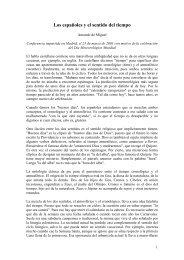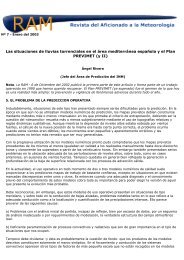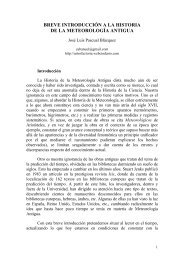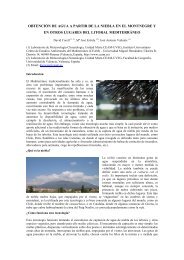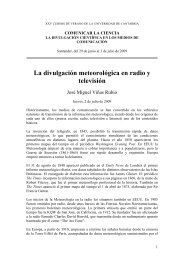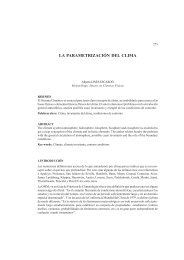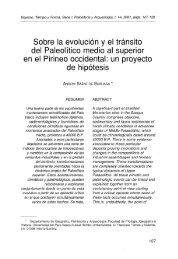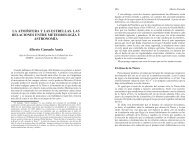Identificación y caracterización del granizo mediante el radar ...
Identificación y caracterización del granizo mediante el radar ...
Identificación y caracterización del granizo mediante el radar ...
You also want an ePaper? Increase the reach of your titles
YUMPU automatically turns print PDFs into web optimized ePapers that Google loves.
AbstractWith the purpose of identifying and characterising hail and improving its riskassesment, a great number of techniques based on troposphere observations have beendev<strong>el</strong>oped. In general, all these techniques are based on the use of meteorological <strong>radar</strong>, thismeans that all of them depend on geography and the used <strong>radar</strong>. These surface hail identificationmethods are described and evaluated in this thesis. Different algorithm and techniqueimprovements are proposed with the aim of improving the results. Moreover, a new maximumexpected surface hail size technique and a proposal for nowcasting convective c<strong>el</strong>l <strong>radar</strong>parameters are also presented. These forecasts will give the possibility to nowcast theprobability of hail and the maximum expected hail size.Many of these existing hail identification and characterisation methodologies are basedon equations or empirical r<strong>el</strong>ationships that need to be study region and used <strong>radar</strong> custommade.For this reason, this thesis proposes a new technique which has improvements on <strong>radar</strong>algorithms, the integration of <strong>radar</strong> data with mesoscale and thermodynamic information and theuse of boxplots.The 2004 and 2005 Ebro Valley hail events observed during hail campaigns have beenused to achieve these ends. To study these events, the available data during these campaignshave been the C band <strong>radar</strong> observations, the MM5 mesoscale meteorological outputs and thesurface hail size observations (provided by the University of Leon). All these data have beenintegrated by using the thesis dev<strong>el</strong>oped software, RHAP, Rainfall events and HailstormsAnalysis Program. After analysing all the s<strong>el</strong>ected events, precipitation structures have beenidentified, characterised and tracked obtaining a large number of <strong>radar</strong> parameters for each one.From these results, hail identification and characterisation techniques have been improved anddev<strong>el</strong>oped and a methodology to obtain <strong>radar</strong> parameters nowcasting mo<strong>d<strong>el</strong></strong>s has been proposed.Taking into account hail identification, it has been obtained that the kinetic energy fluxis the best parameter for distinguishing between hail of any size and no-hail precipitation in theEbro valley region. Moreover, results have shown non-significant difference between all <strong>radar</strong>parameters that are corr<strong>el</strong>ated with hail precipitation. On the other hand, new study region andused <strong>radar</strong> custom-made probability of hail equations have been obtained. Moreover, by usingboxplots, it has also been possible to estimate maximum surface hail size with the best results incase of hail the size between 10 and 30 mm. It can be concluded there is no <strong>radar</strong> parameter thatcan be s<strong>el</strong>ected with significance difference as the best parameter for distinguishing betweenhail and no-hail precipitation and for estimating the maximum expected hail size. Due to theseXIII



